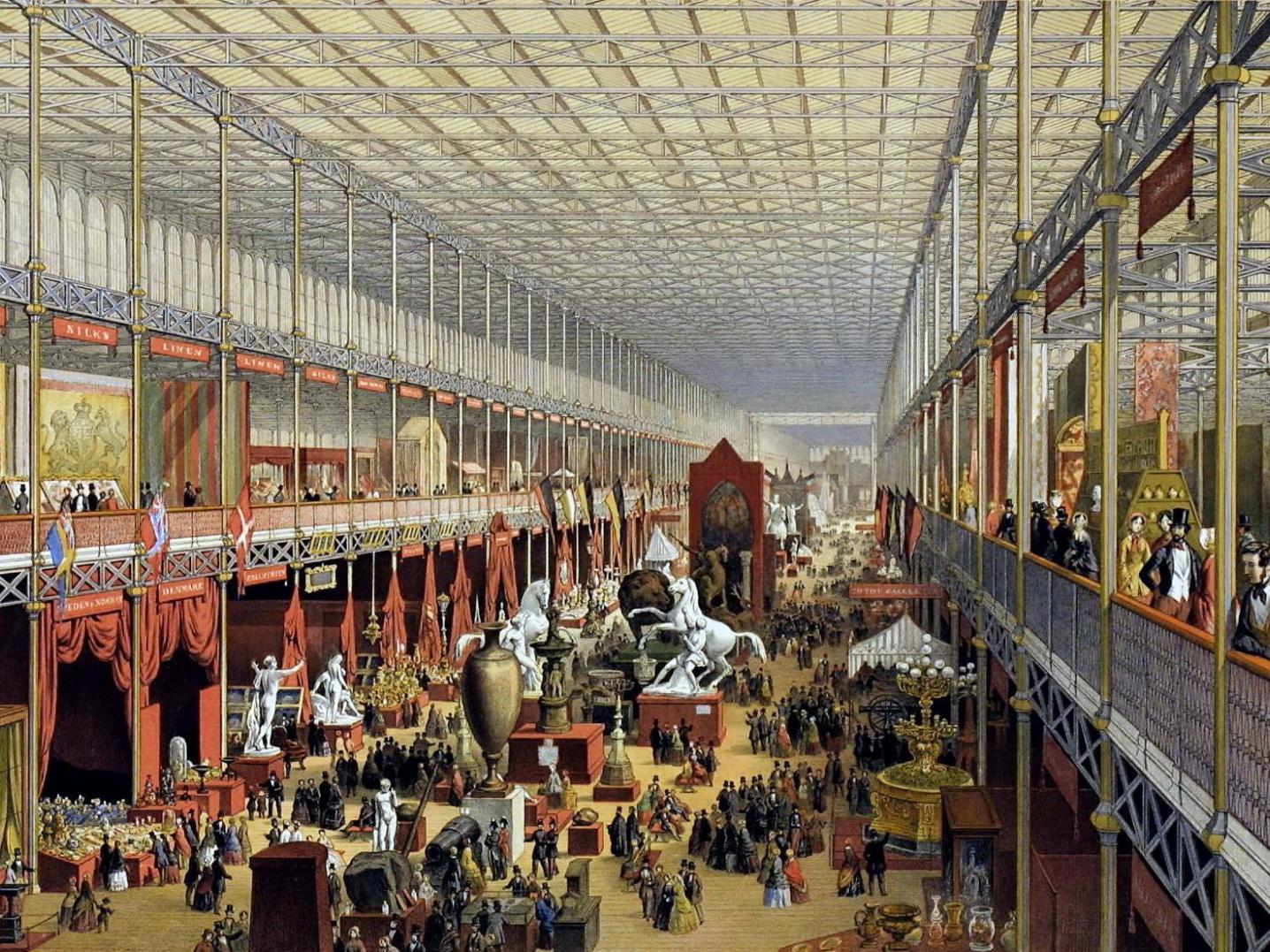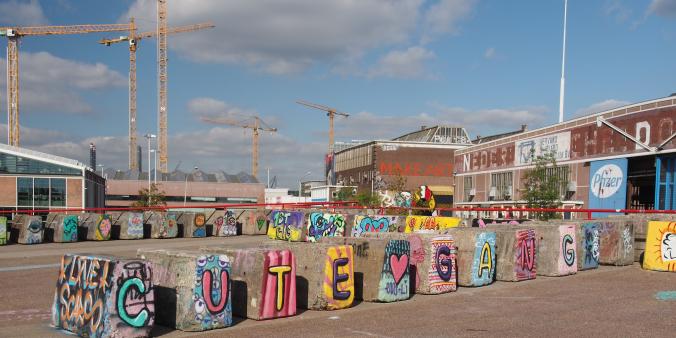
Beyond expats and nomads: on cosmopolitanism in the arts
DutchCulture asked researcher Errol Boon to critically respond to DutchCulture’s colloquium on cosmopolitanism in the arts, where dr. Ginna Brock gave a lecture titled ‘Non-Linear Belonging as a Creative Companion to Cosmopolitan Realisation’.
The rise of the cosmopolitan ideal in the 19th century
"We are living in a period of most wonderful transition, which tends rapidly to the accomplishment of that great end to which, indeed, all history points – the realisation of the unity of mankind. (..) [Through the] achievements of modern invention (..) distances which separated the different nations (..) [are] gradually vanishing." (Martin 1877: 204-5)
With these words, spoken at the Great Exhibition of London in 1851, Prince Albert gave expression to the typical 19th century optimism that the internationalisation of the works of arts and industry could help bring about the cosmopolitan unity of mankind. Ever since Diogenes of Sinope declared ‘I am a citizen of the world’ (kosmopolitês), the ethical and political implications of cosmopolitanism have been discussed widely among philosophers and politicians. Within this ethical and political discourse, cosmopolitanism is generally defined as the belief that all people, despite their cultural and personal differences, are essentially citizens of the same community, and moreover, that this global sociality ethically outweighs other forms of sociality, such as that of the nation state (see e.g. Kleingeld & Brown 2019). However, discussions about the relevance of arts and culture for the realisation of the cosmopolitan ideal especially flourished in the 19th century, when certain ideas arose that still fuel our present-day understanding of artistic internationalisation.
With the great economic and technological transformations of the 19th century - such as the creation of international railways, the development of mass communication, the invention of lithographic printing and the growth of a bourgeois economy – an international cultural sector emerged in Europe, consisting of international opera houses, publishers, galleries and other parties (Figes 2019). This new infrastructure, together with an impersonal and enlarged free market, made it easier for artworks to be reproduced and exported to foreign countries. Within this internationalisation of arts, cosmopolitanism became the key ethical justification of this internationalisation. Consider in this respect, for instance, what art critic and journalist Théophile Thoré wrote, four years after Prince Albert’s speech:
"When the arts of all countries, with their native qualities, have become accustomed to reciprocal exchanges, the character of art will be enriched everywhere to an incalculable extent, without the genius peculiar to each nation being changed. In this way (..) a universal school is formed, familiar with the world, to which nothing human will be foreign." (Thoré 1855: 83; translated by Figes 2019: 239)
While one could argue that the ideology of artistic cosmopolitanism historically followed from the internationalisation of the cultural economy (as argued by e.g. Figes 2019), the paradigmatic idealist expressions of Prince Albert and Thoré are formulated the other way around: cosmopolitanism as the ideal motivation for the internationalisation of the arts and the legitimisation of intercultural exchanges. They believed that by either creating or reaffirming existing commonalities between people from different (European) cultures, the artistic transfers, translations and exchanges among countries could strengthen international fraternity. The idea was not only that traveling would liberate the artist from narrow-mindedness, but also that the artist’s work, once liberated from petty prejudices, could attain a universal quality through international exchange that would subsequently persuade the public to put their particular socialites into perspective. Hence, it was in particular the artist, whose creative freedom should not be confined by artificial bounds and borders, who was expected to prioritise the universal brotherhood over the contingent bonds with a community of a city or nation.
Interestingly, the artistic cosmopolitism of the 19th century was not always believed to be at odds with the existence of national identity, as illustrated for instance by Thoré’s lines above (‘without the genius peculiar to each nation being changed’). We also see this in 19th century revolutionaries such as Giuseppe Mazzini, who thought of cosmopolitanism as being complementary to the existence of national interests, ‘so long as the rise of an aggressive nationalism could be prevented through an adequate sentimental education’ (Mazzini 2009: 2). Thus, the 19th century became the age of both artistic cosmopolitanism and of (cultural) nationalism (cf. Figes 2019: 240); sometimes actually reconciled (as in the case of Thoré and Mazzini), sometimes not at all (as in the case of the nationalist art of the later Wagner), and sometimes very questionably, as in the case of Victor Hugo advocating a European union yet with the condition that French be its language and Paris its capital (Hugo 1985, vol. 10: 302). This paradoxical combination of nationalism and cosmopolitanism is still in place, as can be seen in the cosmopolitan terms with which national governments explain their international cultural policy. Consider, for instance, the Dutch international cultural policy of 2021-2024 that explicitly uses the United Nations’ framework of the Sustainable Development Goals to explain its mission; although the policy naturally remains motivated by national interests (cf. Bul 2019).
We still act and think on the basis of these 19th century ideas. Not only with regard to this paradox of nationalism and cosmopolitanism, but first and foremost with respect to the general assumption of the cosmopolitan ideal as the essential legitimisation of artistic internationalisation (Boon 2020). Through intercultural exchange, we believe that the arts can enrich us with foreign and unfamiliar perspectives that confront us with the contigency and ambiguity of our own values; hence, the cultural ‘hospitality’ of museums and festivals towards artists from abroad is valued on the basis of an expected katharsis of our narrow-minded prejudices, leading to the awareness of the equality of all cultures, the unity of mankind. In showing foreign films and documentaries to children, creating international exhibitions in museums, translating books from various parts of the world and stimulating artists and cultural workers to do residencies, collaborations and tours abroad to broaden their horizons – in all these encounters the tacit assumption is that intercultural exchange is the best education for global citizenship (a viewpoint explicitly advocated by Appiah 2008).

Disconnected pseudo-cosmopolitanism: the nomad and the expat
However, the idea of internationalisation as ‘anyhow good’ is tilting (cf. Janssens 2018). One important reason for this is that the cosmopolitan justification of artistic internationalisation is problematised by our present globalised age. Although at first sight globalisation seems to have realised the cosmopolitan ideal - establishing a ‘global village’ where we exchange cultural expressions with our ‘neighbours’ at the other side of the world - globalisation has instead led to the often criticised disconnectedness of the art world (Boon 2019). Though it may sound counterintuitive, one could argue that globalisation has problematised rather than realised the cosmopolitan dream in the arts. The crux of this problem is that in a globalised world, internationalisation can uproot artists from any connection with any sociality. As a result, the international arts scene is often characterised by competition, exploitation and domination, rather than the original cosmopolitan ideals of intercultural enrichment and equality. Let’s look at two gestures of this contemporary pseudo-cosmopolitanism.
First, one of the most striking gestures of pseudo-cosmopolitanism is the precarious condition of the so-called nomadic artist. Whereas artists previously only travelled to perform a work, today they often also need to travel to create their work. As a result, internationalisation, which is mostly presented as an opportunity, often turns out to be a bare necessity in order to survive, especially for performing artists. In order to make a living from their work, these nomadic artists are often forced to be constantly on the move, flexibly hopping from one place to another without having time to culturally, socially and personally engage with a place. Researcher Annelies van Assche, whose PhD research examined precarity among dancers in the international artworld of Berlin and Brussels, called this lifestyle ‘living from your suitcase’ (Tielens 2018, cf. Van Assche 2020). This is a widespread phenomenon that we can interpret as a form of alienation from (the notion of) one’s home: instead of a place where you live, one’s home transforms into a hub from where you work, becoming ‘a changing network of relations’, as one interviewee defined the word home.
The figure of the nomadic artist is not at all the realisation of the cosmopolitan ideal of interculturality and equality, since the involuntary nomad is forcibly subjected to a globalised infrastructure, alienated from a genuine sense of belonging and disconnected from any particular local culture. This figure is well illustrated by artist and performer Sarah Vanhee, who (in an interview with Tom van Imschoot) compares the nomadic artist with a ‘cut-out figure’:
"You are presumed to be exceedingly flexible, preferably young, always ready to travel, with no family and not too many commitments. In short, you have to cultivate the illusion that you can cut all your connections, that at any moment you can cut yourself off and become a totally cut-out figurine. It is being sold as an attitude of boundless freedom, but what is behind it is an ideologically motivated demand for ultimate flexibility, one that makes your existence especially vulnerable and precarious. (...) I think it makes us incredibly weaker, because it turns us into a kind of pulled-apart, detached cosmopolitans. (..) It makes everything very fleeting and temporary. It detaches us from our own environment, given that it is difficult to maintain friendships and relationships in the places where we live." (Van Imschoot 2018)
As precarious as the nomadic artist is, as complacent is the second prominent gesture of pseudo-cosmopolitanism, namely what Maarten Doorman recently called ‘the global world of art’ (Doorman 2020). With this term, Doorman refers to the generic art world of prominent museums, wealthy galleries and international festivals which bears the same characteristics all around the globe and does not have an intrinsic connection with a specific locality. In this generic world, the value of art is determined by a worldwide market hierarchy, in which cultural production is traditionally oriented towards a Western centre. Hence, the cosmopolitan ideal of global fraternity, international equality and reciprocal intercultural exchange is often problematised rather than realised in this quasi-global, generic culture industry, where take-the-money-and-run-capitalism proliferates instead of honest intercultural encounters and fair international cultural collaboration (Bul 2018).
Beside the figure of the nomadic artist, we thus find the stereotypical figure of the expat, who sees him- or herself as a cosmopolite, working and living all around the world. However, in a globalised world where physical distances do not automatically imply demographical differences (cf. Van Imschoot 2018) - that is, where a subway ticket to a suburb often gives access to greater cultural diversity than a flight ticket to another gentrified city centre – in this world the artistic expat represents only a pseudo-cosmopolitanism. Rather than the imagined cosmopolitan vanguard that unites and reconciles a multitude of global cultures in one life, the stereotypical expat of pseudo-cosmopolitism represents just another sub-culture, a highly privileged diaspora that is often exploitative towards other sub-cultures. There are plenty of stories about star-curators, international artists and successful bookers who are not only disconnected themselves, but in one way or another (often unintentionally) also demand such detachment from local artists, as an often painful sacrifice to the generic and rootless global art world (Graan 2018). In this manner the cosmopolite has skyjacked the aesthetics of cosmopolitanism: while enjoying the symbolic capital of its moral appearance, the cosmopolite’s world actually is the smallest.
Towards rooted cosmopolitanism
Thus we see how the cosmopolitan ideology, which had to ethically ground cultural internationalisation, is distorted through globalisation into a rootless and disconnected pseudo-cosmopolitanism that manifests itself in the figure of the nomad and expat. Is there a way to save artistic cosmopolitanism from becoming rootless in a globalised age?
If we want to prevent cosmopolitanism for becoming rootless, one could argue that artistic practices should be rooted, embedding one’s cosmopolitan outlook on the world within the locality one belongs to (cf. Vanackere 2019). In contrast to both the German romantic critique of Bodenlosigkeit and the Soviet antisemitic pejorative ‘rootless cosmopolitanism’, which both criticise cosmopolitanism in favour of the nation state, one could make a case for cosmopolitanism that is rooted in a locality that is not defined top-down. Although the local was of hardly any interest in the cosmopolite modernist traditions, one could argue that in a globalised world, where the difference between local and global has faded, the cosmopolitan ideal is perfectly applicable to a sense of belonging to a locality (Doorman 2020). Such a ‘translocal’ formulation of cosmopolitanism could articulate and bridge the old rigid opposition between the local and the global by promoting artistic activities that are oriented on other parts of the world without losing their intrinsic bonds with the locality they belong to (cf. Boon 2020). Thus, by truly engaging and investing in local cultures, and by genuinely acknowledging the difference and otherness of other cultures instead of subsuming them under a void and generic global art world, this translocal cosmopolitanism might be capable of revitalising the cosmopolitan ideal of intercultural equality and enrichment.Ginna Brock on cosmopolitanism in the arts
What will it actually take to realise this translocal cosmopolitanism? At a recent colloquium on cosmopolitanism in the arts, organised by DutchCulture, American-Australian lecturer and playwriter Ginna Brock (University of Sunshine Coast) presented her article Cosmopolitanism beyond the polis, in which she outlines this sense of belonging as the necessary condition for every cosmopolitan endeavour. According to Brock, the cosmopolitan ideal must be reformulated by replacing the notion of the polis (state) – which, according to her, inherently leads to exclusion and domination - by the concept of a hestia (hearth). That is, rather than being a citizen (politês) of the world, Brock stresses that a cosmopolite is at home in the world. Brock thus defends the thesis that local rootedness is a condition of possibility for genuine artistic cosmopolitanism. Therefore, by rethinking cosmopolitanism in terms of hearth and belonging, Brock might be able to revitalise our cosmopolitan justification of cultural internationalisation as described above.
In order to analyse whether Brock’s hearth-centred understanding of cosmopolitanism is indeed able to renew the cosmopolitan ideal, we should take a closer look at what Brock calls the individual’s ‘hestian composition’. Brock asserts that in order for the individual to claim to be a citizen of the world, one must first understand how one’s own individual identity consists of a layered composition of multiple levels of belonging, e.g. to a family, a football club, a nation, human kind etc. Cosmopolitanism is then defined by Brock as the individuals’ progression towards reconciling a multiplicity of belonging.
With this definition, Brock turns away from a traditional understanding of cosmopolitanism as predominantly focussed on humans as citizens. Before the construction of the polis, according to Brock, society was structured around the hearth (hestia), i.e. ‘a common communal space within the home, which can be viewed as an external manifestation of the innate human impulse towards connectivity and belonging.’ According to Brock, a hestia-centred mentality shifts our understanding of self as ‘citizen of the world’ to an awareness of belonging to the world, which emphasizes cooperation and compassion over competition and domination. Whereas being a citizen of a polis is always conditional, depending on political, cultural, social or moral rules, and hence inherently exclusive (differentiating between ‘us’ and ‘them’), the hestian sense of belonging to the world is unconditionally inclusive, for it simply is. Thus, Brock depoliticizes cosmopolitanism into an ontological concept, citing Martin Heidegger: ‘to be is to dwell’.
In order to achieve an understanding of belonging to the world hearth, an individual must first traverse through narrower forms of belonging. As Edward Edinger states: ‘It is not possible to worship at the hearth of the human family―that is the cosmopolitan whole―until one has first worshiped, and still worships, at the hearth of one’s more particular locality. For the larger and more comprehensive viewpoint to be authentic, it must be based on a solid relation to one’s particular origins; otherwise, cosmopolitanism can be nothing more than alienation" (Edinger 1994, Chapter 4). Similarly, Pauline Kleingeld holds that ‘that our narrower loyalties develop before the broader ones do. Thus, as a matter of moral education, children may need to learn to broaden the scope of their affiliations from that of the family, to the local community, to the country, to the community of all human beings’ (Kleingeld 2012: 37). Building on this line of thought, Brock argues that the cosmopolitan impulse is ‘ontologically first, yet psychologically last to be realised’. Cosmopolitanism, in other words, is the progression towards an awareness of our cosmic belonging that is always already in place: a psychological return to the ontologically original belonging to the world.
According to Brock, an individual’s ability to transcend different hestian identities, as well as an individual’s openness to recognise and respect alternative hestian constructions, depends on the security of one’s own hestian composition. After all, the confrontation with a foreigner always calls into question an individual’s established understanding of dwelling in the world. In response to the appearance of the other we have two options: hospitality or hostility. Hospitality occurs when the individual is secure enough in his or her own hestian composition to reconcile the feelings of fear and fascination experienced through encountering the foreign. Hostility, on the other hand, stems from either fear― fear that this unknown entity will somehow ‘contaminate’ what has been traditionally ‘one’s own’― or the failure to reconcile one’s own vulnerability of dispossession, which prevents an individual from recognising ‘self’ within the displaced ‘other’. The inability impedes compassion.
By repositioning hestia at the centre of cosmopolitanism, Brock says we could value compassion and cooperation over competition and domination. Compassion is, according to her, necessary to counter self-absorption and polis-absorption, where an individual becomes wholly identifies with one particular way of viewing the self and denies cosmic belonging.

Critical voices: genuine change or just lip service?
Following Brock’s lecture, many critical questions were raised during DutchCulture’s colloquium. Most of the questions were concerned with the practical implications of Brock’s proposed reformulation of the cosmopolitan ideal: what will a hestia-centred cosmopolitanism concretely look like in the arts? Will it indeed fulfil its promises or evaporate as a castle in the air when put into practice?
Gable Roelofsen, artistic director of Het Geluid Maastricht and all-round performing arts professional, opened the debate by criticising ‘the poverty of elitism’. With this notion, Roelofsen highlights a moral dimension of the disconnectedness of the global world of art, namely the tendency to complacently advocate values like compassion and interculturality, while one’s practice actually is too detached or one’s thinking too abstract in order to genuinely invest in the realisation of these proclaimed values. ‘Subscribing to cultural codes or saying ‘’I am pro diversity’’ is not enough – you should have a lived experience before writing it down. Otherwise it is just a short-cut, mere lip service without all the necessary hard work behind it.’ Brock’s reformulation of cosmopolitanism likewise risks becoming a ‘symbiotic Gesammtkunstwerk, in which we all cuddle each other for being so compassionate, while reality actually remains unchanged.’
According to Roelofsen, if Brock’s proposal is to be more than just another short-cut, then it is necessary to work out the practical implications to such an extent that her exposé takes notice of the various difficulties one might run into when going abroad. Thus, in a somewhat Popperian manner, Roelofsen states that Brock should actively attempt to problematise her own theory by looking for examples of difficult realities that might contradict her cosmopolitan ideal. Reality does not always follow the general terms and idealistic blueprints – and it is at these rough edges where our emancipatory work really begins. ‘It is a short cut to say: I am compassionate and all walls should be torn down. That does not address the reality we actually live in.’ The work only begins after acknowledging that words are not enough.
The subsequent discussion at the colloquium mainly consisted of a critical conversation around various of such disturbing realities that require Brock to elaborate her idea of ‘cosmic belonging’ more concretely and practically. One example given by Roelofsen, paraphrasing Brené Brown’s paradox of empathy, is that people with the most empathy generally also have the most boundaries. If that is the case, Brock, whose project consists of transcending the boundaries of the polis in order to strengthen our empathy with the rest of mankind - needs to explore further how her proposal relates to such paradoxes.
A similar point about boundaries was raised by Lara Staal, curator and dramaturg at NTGent, Münchner Kamerspiele and DAS Theatre, who addressed the controversial question, originally formulated by Paul Scheffer, whether we need borders to define our democratic rights (cf. Scheffer 2016). A border does not only, as Brock highlights, determine who is part of the community and who is not, but it also generates a sense of belonging and accordingly of responsibility, according to Staal. ‘If borders would be justified to the extent that they can exercise the idea of a cosmic belonging’, as Staal paraphrases Brock, ‘the urgent question becomes again: how to do that? And what role can artists and cultural institutions play in this? What are actual examples in which we do practice this feeling of cosmic belonging despite (or, alternatively, by virtue of) the actual existence of borders?’ In addition to Brock’s ideal theory, Staal seems to suggest that we need a non-ideal theory that addresses the question of how the actual non-ideal reality of nation states and borders could help us to realise the ideal of cosmic belonging.
As an example of fleshing out Brock’s theoretical exposé more concretely, Staal proposes that acknowledging the multiplicity of ourselves and recognising our own foreignness, as emphasised by Brock, can be put into practice by learning to have a genuine conversation, that is by being open to changing your mind through dialogue. Thus, Staal illustrated how micro-analyses of our conversations, van force us to consider whether we are in fact able to doubt and rethink our prejudices, or instead engage in discussions just to hear ourselves. Regarding this susceptibility to existential or ideological change – that is, accepting that one doubts, reviews and changes one’s mind, that ‘change actually is our condition humaine and the essence of democracy’ - the work of artists and cultural workers can be of particular importance, according to Staal.
Another undeniable reality that Brock’s ideal-theory does not immediately seems to address, was pointed out by Roelofsen, who remarked that Brock’s emphasis on the hearth as the primal locus of cosmopolitan encounters risks ignoring the fact that, as bell hooks (Gloria Jean Watkins) has demonstrated, the home is not at all a safe space for many women around the world. Whereas Brock proposes exactly this security as a precondition for cosmopolitanism, Roelofsen continued to stress that the real question lies in how this applies to situations in which this precondition is not met: ‘If we talk about compassion, suddenly everything is elevated; everybody is related the cosmos. But how do we deal with the moments when we do not have a secure home or when compassion needs certain borders?’
Perhaps even more problematic is the case of stateless people and refugees, as pointed out by both artist Catherine Schwarz and Sudeep Dasgupta, associate professor in the Department of Media and Culture at the University of Amsterdam. Brock’s reformulation of cosmopolitism in terms of ‘belonging’ and ‘hearth’ hardly seems to apply to the reality of millions of people who have no natal home - for them being is not belonging, but rather being displaced from what could have been one’s home. As Dasgupta remarks: ‘From where one begins problematising cosmopolitanism, is important. For people who have been marked by displacement, the security of the home is a fiction and I am wondering whether this distinction between hestia and polis might be useful for them.’ Instead, Dasgupta suggests that political institutions and documents, such as the European court of justice, the refugee convention of 1951, or the UN convention on human rights are of more use.
To conclude: a world passport
At the very end of the colloquium, Annick Schramme, professor in international cultural policy at the University of Antwerp, brought up an interesting performative example in line with Dasgupta’s remark. Schramme recalled an intervention by peace activist Garry Davis during one of the first General Assemblies of the United Nations in 1948. Davis proclaimed: ‘We, the people, want the peace which only a world government can give. (..) The sovereign states you represent divide us and lead us to the abyss of total war.’ Davis gave up his U.S. passport and called himself a citizen of the world. ‘Without a passport,’ Schramme explained, ‘he was actually nobody, for world citizenship does not exist juridically.’
With this example, Schramme made clear that cosmopolitanism is literally something that does not exist. In other words, it something to strife for; not as a return to an original state of being but as step forwards in history. Davis himself founded the organisation The Government of World Citizens and started to issue world passports. Interestingly, the Dutch theatre maker Marjolijn van Heemstra made a performance about Garry Davis, which included trying to travel with Davis’s world passport, as a result of which she was detained for investigation. With her performance, she not only revealed the inexistence of world citizenship, but also of equal mobility rights: although she might have been detained for a while, it is not likely that Van Heemstra will get in real trouble, since she always has a Dutch passport to fall back on if the world passport does not work. For a Libyan or Pakistani such an experiment as Van Heemstra undertook would be far more dangerous (and far less interesting) enterprise. Van Heemstra’s performance thus raises the urgent question: if the world is fundamentally ours, if we cosmically belong to the world, as Brock extensively argues, why don’t we all have equal legal rights around in it? Of course, the answer lies in the polis and not in hestia.
Both the most original aspect of Brock’s hearth-centred cosmopolitanism and the foremost target of its critique boils down to the fact that she depoliticises cosmopolitanism. Although Brock shows very well how our true cosmopolitan encounters are only possible by virtue of local belonging, thereby rescuing cosmopolitanism from becoming rootless, one may question whether replacing the polis by the hearth is the best way to accommodate this rooted cosmopolitanism. Indeed, in a very ontological, Heideggerian manner we might be fundamentally ‘at home’ in the world; that is, we normally would not consider the world as such as a foreign place. However, for the ethical purposes of cosmopolitanism, this ontological concept seems to have very little relevance. From an ethical and everyday understanding of ‘belonging’ – which is so different that we might call it homonymous to the ontological understanding - saying that we are always already at home in the world is simply absurd, for when I’m in the midst a Brazilian jungle for the first time or lost in a suburb of Tokyo, I definitely do not feel at home. Brock’s ‘cosmic belonging’ cannot provide a foundation for the ethical purposes of cosmopolitanism, since it is simply about something else and therefore of precisely no consolation or help to refugees and stateless people who are urgently in need of a polis, not of a hearth. Cosmopolitanism is by definition a political concept based on a normative ethical ideal instead of a hestian concept based on a descriptive ontological reality. In other words, following Schramme’s remark, cosmopolitanism is not the case but ought to be the case: it is a political ideal that people like Garry Davis fight for, rather than an ontological condition we only need to recall.
Departing from an ontological understanding, the only practical advice Brock is able to offer is directed to our condition humaine that allegedly always already exists. She describes this as the process of making the foreign familiar, i.e. remembering that the other is essentially just like you. However, one might wonder here whether the familiar reality should be the criterion of respecting the foreign. Wouldn’t such a mentality pave the way for exactly the ‘domination and exclusion’ Brock ascribed to the polis?
In short, we may say that grounding the ethical purposes of cosmopolitanism in postulated ontological or physical realities runs the risk of depoliticising, disarming and weakening our ideal of intercultural equality and enrichment. If we want to prevent cosmopolitanism from becoming rootless in a globalised age, Brock offers a helping hand in criticising the pseudo-cosmopolitanism of the precarious nomad and the detached expat, but in order to reach beyond their practices we must acknowledge that cosmopolitanism, also in the arts, is and ought to be a political ideal.
Literature
- Appiah, Kwame Anthony (2008). "Chapter 6: Education for global citizenship". In: Yearbook of the National Society for the Study of Education. 107 (1): 83–99.
- Boon, Errol (2019). 'What does cultural Internationalisation mean anno 2021?’. Amsterdam: DutchCulture.
- Boon, Errol (2020). ‘Translocality: artistic internationalisation after the corona crisis’. Amsterdam: DutchCulture.
- Bul, Maarten (2018). ‘Report on fair international cultural cooperation #1 – funding parties. Conventions and pratical issues in funding international activities’. Amsterdam: DutchCulture.
- Bul, Maarten (2019). ‘Make internationalism great again. A case for fair international cooperation.’ Amsterdam: DutchCulture.
- Brock, Ginna (2017). ’Cosmopolitanism beyond the polis: creative memory works and reimaging the relationship between Xenia and Hestia.’ In: Beyond Cosmopolitanism: Towards Planetary Transformations. Edited by Ananta Kumar Giri. Londen: Palgrave Macmillan.
- Brock, Ginna (2020). ‘Non-Linear Belonging as a Creative Companion to Cosmopolitan Realisation’. Amsterdam: DutchCulture.
- Doorman, Maarten (2019). 'Far-off and nearby. On translocality in the arts'. Amsterdam: Nieuw Dakota.
- Doorman, Maarten (2020). 'On translocality in the arts'. Amsterdam: DutchCulture.
- Edinger, Edward (1994). The Eternal Drama: The inner Meaning of Greek Mythology. Boston, Massachusetts: Shambhala Publications, Inc.
- Figes, Orlando (2019). Europeans: Three Lives and the Making of a Cosmopolitan Culture. London: Penguin Books.
- Government of The Netherlands (2020). International Cultural Policy 2021-2024.
- Graan, Mike de (2018). Beyond Curiosity and Desire: Towards Fairer International Cooperation in the Arts. IETM, On the Move en Dutchculture.
- Hugo, Victor (1987). Oeuvres completes. Edited by Jacques Seebacher and Guy Rosa. vol 10. Paris: Robert Laffont.
- Janssens, Joris (2018). (Re)framing the International. On new ways of working internationally in the arts. Brussel: Flanders Arts Institute.
- Kleingeld, Pauline (2012). Kant and Cosmopolitanism: The Philosophical Ideal of World Citizenship. Cambridge: Cambridge University Press.
- Kleingeld, Pauline and Brown, Eric (2019). ‘Cosmopolitanism’. In: The Stanford Encyclopedia of Philosophy.
- Martin, Theodore (1877). The Life of His Royal Highness the Prince Consort. Volume 2. New York: D. Appleton & Co.
- Mazzini, Giuseppe (2009). A cosmopolitanism of nations: Giuseppe Mazzini’s Writings on Democracy, Nation Building, and International Relations. Edited by Stefano Recchia and Nadia Urbinat. Princeton: Princeton University Press.
- Scheffer, Paul (2016). De vrijheid van de grens. Amsterdam: De bezige bij.
- Thoré, Théophile (1855). ‘Des tendances de l’art au xix siecle‘. In: Revue universelle des arts, vol. 1.
- Tielens, Filip (2018). ‘Loon naar dansen, daar is nog werk aan’. Brussels: Rekto Verso.
- Vanackere, Annemie (2019). ‘From local spectator to international player’. Amsterdam: DutchCulture.
- Van Assche (2020). Labor and Aesthetics in European Contemporary Dance: Dancing Precarity. London: Palgrave Macmillan.
- Van Imschoot, Tom (2018). ‘De nood aan een andere taal’. Brussel: Kunstenpunt.









